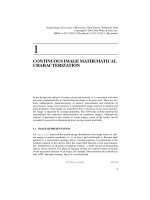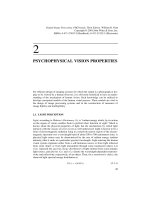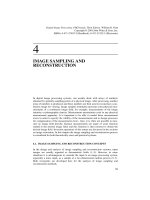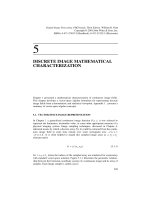Tài liệu Xử lý hình ảnh kỹ thuật số P1 ppt
Bạn đang xem bản rút gọn của tài liệu. Xem và tải ngay bản đầy đủ của tài liệu tại đây (153.34 KB, 19 trang )
3
1
CONTINUOUS IMAGE MATHEMATICAL
CHARACTERIZATION
In the design and analysis of image processing systems, it is convenient and often
necessary mathematically to characterize the image to be processed. There are two
basic mathematical characterizations of interest: deterministic and statistical. In
deterministic image representation, a mathematical image function is defined and
point properties of the image are considered. For a statistical image representation,
the image is specified by average properties. The following sections develop the
deterministic and statistical characterization of continuous images. Although the
analysis is presented in the context of visual images, many of the results can be
extended to general two-dimensional time-varying signals and fields.
1.1. IMAGE REPRESENTATION
Let represent the spatial energy distribution of an image source of radi-
ant energy at spatial coordinates (x, y), at time t and wavelength . Because light
intensity is a real positive quantity, that is, because intensity is proportional to the
modulus squared of the electric field, the image light function is real and nonnega-
tive. Furthermore, in all practical imaging systems, a small amount of background
light is always present. The physical imaging system also imposes some restriction
on the maximum intensity of an image, for example, film saturation and cathode ray
tube (CRT) phosphor heating. Hence it is assumed that
(1.1-1)
Cxytλ,,,()
λ
0 Cxytλ,,,()A≤<
Digital Image Processing: PIKS Inside, Third Edition. William K. Pratt
Copyright © 2001 John Wiley & Sons, Inc.
ISBNs: 0-471-37407-5 (Hardback); 0-471-22132-5 (Electronic)
4
CONTINUOUS IMAGE MATHEMATICAL CHARACTERIZATION
where A is the maximum image intensity. A physical image is necessarily limited in
extent by the imaging system and image recording media. For mathematical sim-
plicity, all images are assumed to be nonzero only over a rectangular region
for which
(1.1-2a)
(1.1-2b)
The physical image is, of course, observable only over some finite time interval.
Thus let
(1.1-2c)
The image light function is, therefore, a bounded four-dimensional
function with bounded independent variables. As a final restriction, it is assumed
that the image function is continuous over its domain of definition.
The intensity response of a standard human observer to an image light function is
commonly measured in terms of the instantaneous luminance of the light field as
defined by
(1.1-3)
where represents the relative luminous efficiency function, that is, the spectral
response of human vision. Similarly, the color response of a standard observer is
commonly measured in terms of a set of tristimulus values that are linearly propor-
tional to the amounts of red, green, and blue light needed to match a colored light.
For an arbitrary red–green–blue coordinate system, the instantaneous tristimulus
values are
(1.1-4a)
(1.1-4b)
(1.1-4c)
where , , are spectral tristimulus values for the set of red, green,
and blue primaries. The spectral tristimulus values are, in effect, the tristimulus
L
x
– xL
x
≤≤
L
y
– yL
y
≤≤
T– tT≤≤
Cxytλ,,,()
Yxyt,,() Cxytλ,,,()V λ()λd
0
∞
∫
=
V λ()
Rxyt,,() Cxytλ,,,()R
S
λ() λd
0
∞
∫
=
Gxyt,,() Cxytλ,,,()G
S
λ() λd
0
∞
∫
=
Bxyt,,() Cxytλ,,,()B
S
λ() λd
0
∞
∫
=
R
S
λ() G
S
λ() B
S
λ()
TWO-DIMENSIONAL SYSTEMS
5
values required to match a unit amount of narrowband light at wavelength . In a
multispectral imaging system, the image field observed is modeled as a spectrally
weighted integral of the image light function. The ith spectral image field is then
given as
(1.1-5)
where is the spectral response of the ith sensor.
For notational simplicity, a single image function is selected to repre-
sent an image field in a physical imaging system. For a monochrome imaging sys-
tem, the image function nominally denotes the image luminance, or some
converted or corrupted physical representation of the luminance, whereas in a color
imaging system, signifies one of the tristimulus values, or some function
of the tristimulus value. The image function is also used to denote general
three-dimensional fields, such as the time-varying noise of an image scanner.
In correspondence with the standard definition for one-dimensional time signals,
the time average of an image function at a given point (x, y) is defined as
(1.1-6)
where L(t) is a time-weighting function. Similarly, the average image brightness at a
given time is given by the spatial average,
(1.1-7)
In many imaging systems, such as image projection devices, the image does not
change with time, and the time variable may be dropped from the image function.
For other types of systems, such as movie pictures, the image function is time sam-
pled. It is also possible to convert the spatial variation into time variation, as in tele-
vision, by an image scanning process. In the subsequent discussion, the time
variable is dropped from the image field notation unless specifically required.
1.2. TWO-DIMENSIONAL SYSTEMS
A two-dimensional system, in its most general form, is simply a mapping of some
input set of two-dimensional functions F
1
(x, y), F
2
(x, y),..., F
N
(x, y) to a set of out-
put two-dimensional functions G
1
(x, y), G
2
(x, y),..., G
M
(x, y), where
denotes the independent, continuous spatial variables of the functions. This mapping
may be represented by the operators for m = 1, 2,..., M, which relate the input
to output set of functions by the set of equations
λ
F
i
xyt,,() Cxytλ,,,()S
i
λ()λd
0
∞
∫
=
S
i
λ()
Fxyt,,()
Fxyt,,()
Fxyt,,()
Fxyt,,()
Fxyt,,()〈〉
T
1
2T
------ Fxyt,,()Lt() td
T
–
T
∫
T ∞→
lim=
Fxyt,,()〈〉
S
1
4L
x
L
y
-------------- Fxyt,,()xdyd
L
y
–
L
y
∫
L
x
–
L
x
∫
L
x
∞→
L
y
∞→
lim=
∞ xy,∞<<–()
O
·
{}
6
CONTINUOUS IMAGE MATHEMATICAL CHARACTERIZATION
(1.2-1)
In specific cases, the mapping may be many-to-few, few-to-many, or one-to-one.
The one-to-one mapping is defined as
(1.2-2)
To proceed further with a discussion of the properties of two-dimensional systems, it
is necessary to direct the discourse toward specific types of operators.
1.2.1. Singularity Operators
Singularity operators are widely employed in the analysis of two-dimensional
systems, especially systems that involve sampling of continuous functions. The
two-dimensional Dirac delta function is a singularity operator that possesses the
following properties:
for (1.2-3a)
(1.2-3b)
In Eq. 1.2-3a, is an infinitesimally small limit of integration; Eq. 1.2-3b is called
the sifting property of the Dirac delta function.
The two-dimensional delta function can be decomposed into the product of two
one-dimensional delta functions defined along orthonormal coordinates. Thus
(1.2-4)
where the one-dimensional delta function satisfies one-dimensional versions of Eq.
1.2-3. The delta function also can be defined as a limit on a family of functions.
General examples are given in References 1 and 2.
1.2.2. Additive Linear Operators
A two-dimensional system is said to be an additive linear system if the system obeys
the law of additive superposition. In the special case of one-to-one mappings, the
additive superposition property requires that
G
1
xy,()O
1
F
1
xy,()F
2
xy,()…F
N
xy,(),,,{}=
G
m
xy,()O
m
F
1
xy,()F
2
xy,()…F
N
xy,(),,,{}=
G
M
xy,()O
M
F
1
xy,()F
2
xy,()…F
N
xy,(),,,{}=
…
…
Gxy,()OFxy,(){}=
δ xy,()xdyd
ε
–
ε
∫
ε
–
ε
∫
1= ε 0>
F ξη,()δx ξ– y η–,()ξd ηd
∞
–
∞
∫
∞
–
∞
∫
Fxy,()=
ε
δ xy,()δx()δy()=
TWO-DIMENSIONAL SYSTEMS
7
(1.2-5)
where a
1
and a
2
are constants that are possibly complex numbers. This additive
superposition property can easily be extended to the general mapping of Eq. 1.2-1.
A system input function F(x, y) can be represented as a sum of amplitude-
weighted Dirac delta functions by the sifting integral,
(1.2-6)
where is the weighting factor of the impulse located at coordinates in
the x–y plane, as shown in Figure 1.2-1. If the output of a general linear one-to-one
system is defined to be
(1.2-7)
then
(1.2-8a)
or
(1.2-8b)
In moving from Eq. 1.2-8a to Eq. 1.2-8b, the application order of the general lin-
ear operator and the integral operator have been reversed. Also, the linear
operator has been applied only to the term in the integrand that is dependent on the
FIGURE1.2-1. Decomposition of image function.
Oa
1
F
1
xy,()a
2
F
2
xy,()+{}a
1
OF
1
xy,(){}a
2
OF
2
xy,(){}+=
Fxy,() F ξη,()δx ξ– y η–,()ξd ηd
∞
–
∞
∫
∞
–
∞
∫
=
F ξη,() ξη,()
Gxy,()OFxy,(){}=
Gxy,()OFξη,()δx ξ– y η–,()ξd ηd
∞
–
∞
∫
∞
–
∞
∫
=
Gxy,() F ξη,()O δ x ξ– y η–,(){}ξd ηd
∞
–
∞
∫
∞
–
∞
∫
=
O ⋅{}
8
CONTINUOUS IMAGE MATHEMATICAL CHARACTERIZATION
spatial variables (x, y). The second term in the integrand of Eq. 1.2-8b, which is
redefined as
(1.2-9)
is called the impulse response of the two-dimensional system. In optical systems, the
impulse response is often called the point spread function of the system. Substitu-
tion of the impulse response function into Eq. 1.2-8b yields the additive superposi-
tion integral
(1.2-10)
An additive linear two-dimensional system is called space invariant (isoplanatic) if
its impulse response depends only on the factors and . In an optical sys-
tem, as shown in Figure 1.2-2, this implies that the image of a point source in the
focal plane will change only in location, not in functional form, as the placement of
the point source moves in the object plane. For a space-invariant system
(1.2-11)
and the superposition integral reduces to the special case called the convolution inte-
gral, given by
(1.2-12a)
Symbolically,
(1.2-12b)
FIGURE 1.2-2. Point-source imaging system.
Hxyξη,;,()O δ x ξ– y η–,(){}≡
Gxy,() F ξη,()Hxyξη,;,()ξd ηd
∞
–
∞
∫
∞
–
∞
∫
=
x ξ– y η–
Hxyξη,;,()Hx ξ– y η–,()=
Gxy,() F ξη,()Hx ξ– y η–,()ξd ηd
∞
–
∞
∫
∞
–
∞
∫
=
Gxy,()Fxy,()
᭺
*
Hxy,()=
TWO-DIMENSIONAL SYSTEMS
9
denotes the convolution operation. The convolution integral is symmetric in the
sense that
(1.2-13)
Figure 1.2-3 provides a visualization of the convolution process. In Figure 1.2-3a
and b, the input function F(x, y) and impulse response are plotted in the dummy
coordinate system . Next, in Figures 1.2-3c and d the coordinates of the
impulse response are reversed, and the impulse response is offset by the spatial val-
ues (x, y). In Figure 1.2-3e, the integrand product of the convolution integral of
Eq. 1.2-12 is shown as a crosshatched region. The integral over this region is the
value of G(x, y) at the offset coordinate (x, y). The complete function F(x, y) could,
in effect, be computed by sequentially scanning the reversed, offset impulse
response across the input function and simultaneously integrating the overlapped
region.
1.2.3. Differential Operators
Edge detection in images is commonly accomplished by performing a spatial differ-
entiation of the image field followed by a thresholding operation to determine points
of steep amplitude change. Horizontal and vertical spatial derivatives are defined as
FIGURE 1.2-3. Graphical example of two-dimensional convolution.
Gxy,() Fx ξ– y η–,()H ξη,()ξd ηd
∞
–
∞
∫
∞
–
∞
∫
=
ξη,()









